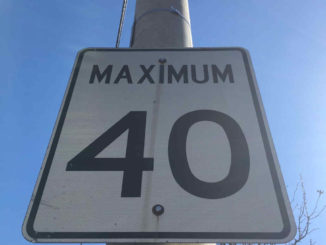Back in the 1970s, Leaside initiated its first comprehensive traffic study, led by the LPOA, to regulate and reduce cut-through traffic.
Controversy raged. Many residents living on Leaside’s quieter streets feared that any traffic plan would divert cars from busy streets onto their own. Hours were spent at every East York traffic committee and council meeting, as Leasiders disputed each other, street against street.
The heat quotient was a lot higher than the light quotient, to say the least.
This was in the days when there were hardly any stop signs anywhere, or turn restrictions. Traffic flowed freely, and at high speed. School crossing guards, occasionally hit by racing commuters, felt like an endangered species.
But eventually traffic control measures were installed, and lo! traffic statistics decreased throughout the neighbourhood.
That was then. And this is now.
All around us are construction sites. Located in the very middle of the city, Leaside has been the beneficiary (if that is the word) of the resulting traffic. Police enforcement of stop signs, turn restrictions, and No Trucks rules is too infrequent. The LPOA and Leaside Unite receive complaints about drivers speeding, failing to stop at stop intersections, and other infractions, from residents all over Leaside.
With the shopping centres built during the last 15 years on Laird Dr. alone, our traffic numbers have once again been climbing, and driver-speed is increasing. This situation can only get worse if ignored.
For years, rather than supporting an internal Leaside study, city staff have proposed major measures like the Leslie Extension. When that was defeated, they proposed a shorter version, the Redway Rd. Extension, to connect Millwood to the Bayview Extension.
Although the concept appealed to quite a few Leasiders who saw it as a quick fix, both extensions were challenged on financial and political grounds. The Redway Extension alone encountered opposition from landowners like Hydro, conservation authorities, and the railways, whose properties would be needed for the route, as well as ratepayer groups in north and south Rosedale, who feared the Redway traffic would be funnelled through their own neighbourhoods.
There is no quick fix. But there are measures which can and should be taken to protect our streets.
The key measure is to embark on a neighbourhood-led traffic study to identify the origins and destinations of cut-through traffic, both retail and development oriented, and during peak commuter periods.
LPOA’s original traffic study objectives are still timely: to reduce through-traffic from the entire residential area (both North and South Leaside); to enhance the residential environment for residents making neighbourhood trips; to protect all residential streets, and avoid directly transferring through-traffic to adjacent streets; and to protect public transit routes, giving priority to public transit.
At the Feb. 26 North York Community Council meeting, Councillor John Parker requested, for information only, advice from city staff regarding both the process for beginning an area-wide traffic study, and the feasibility of reopening the Redway Extension issue.
Staff is to respond at the May 14 NYCC meeting.
LPOA and LU will be there. We need to ensure that any traffic planning for Leaside genuinely meets neighbourhood objectives.





